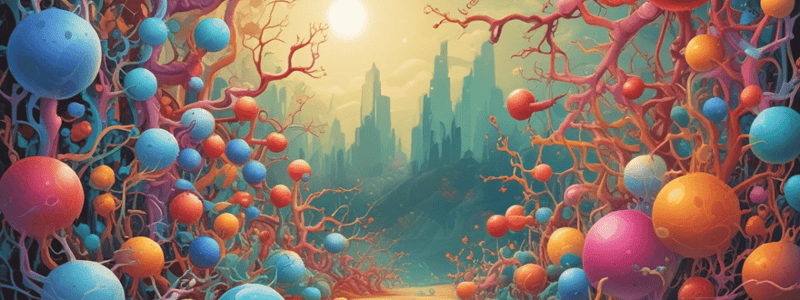Podcast
Questions and Answers
At what temperature is the ideal storage condition for LDH (LD4 and LDS) enzymes?
At what temperature is the ideal storage condition for LDH (LD4 and LDS) enzymes?
Room temperature
What is the effect of hemolysis on enzyme concentration?
What is the effect of hemolysis on enzyme concentration?
Increase
What type of inhibition occurs when a molecule binds to an enzyme's active site, preventing substrate binding?
What type of inhibition occurs when a molecule binds to an enzyme's active site, preventing substrate binding?
Competitive inhibition
What is the main function of the Enzyme Commission (EC)?
What is the main function of the Enzyme Commission (EC)?
What is the effect of lactescence or milky specimens on enzyme concentration?
What is the effect of lactescence or milky specimens on enzyme concentration?
What is the optimal temperature for substrate and coenzymes?
What is the optimal temperature for substrate and coenzymes?
What type of inhibitor binds to the enzyme-substrate (ES) complex, resulting in increased inhibition with increasing substrate concentration?
What type of inhibitor binds to the enzyme-substrate (ES) complex, resulting in increased inhibition with increasing substrate concentration?
What are enzymes with the same catalytic reactions but slightly different molecular structures called?
What are enzymes with the same catalytic reactions but slightly different molecular structures called?
What is the optimal temperature for enzymatic activity?
What is the optimal temperature for enzymatic activity?
What is the temperature coefficient (Q10) that describes the increase in enzyme activity with temperature?
What is the temperature coefficient (Q10) that describes the increase in enzyme activity with temperature?
What pH range is typical for most physiologic reactions?
What pH range is typical for most physiologic reactions?
What effect does refrigeration/freezing have on enzymes?
What effect does refrigeration/freezing have on enzymes?
What is the effect of increasing enzyme concentration on the rate of reaction?
What is the effect of increasing enzyme concentration on the rate of reaction?
What happens to the reaction rate when substrate concentration reaches a maximal value?
What happens to the reaction rate when substrate concentration reaches a maximal value?
What is the function of coenzymes in enzymatic reactions?
What is the function of coenzymes in enzymatic reactions?
What is the term for enzymes that have the same function but differ in their molecular structure?
What is the term for enzymes that have the same function but differ in their molecular structure?
What is the effect of pH on enzyme activity?
What is the effect of pH on enzyme activity?
What is the effect of temperature on enzyme activity?
What is the effect of temperature on enzyme activity?
Flashcards are hidden until you start studying
Study Notes
Enzyme Storage and Stability
- Enzymes can be preserved for a longer period at -20°C due to the inactivation of enzymes.
- 8°C is the ideal temperature for substrate and coenzymes.
- Room temperature is suitable for storing LDH (LD4 and LDS).
Enzyme Inhibition and Activation
- Hemolysis increases enzyme concentration, whereas lactescence or milky specimens decrease enzyme concentration.
- Inhibitors can bind to the enzyme-substrate complex, increasing inhibition with increasing substrate concentration.
Enzyme Nomenclature
- The Enzyme Commission (EC) standardized enzyme nomenclature in 1961, with revisions in 1972 and 1978.
- Enzymes are classified based on their biochemical functions, substrate, and reaction catalyzed, with a unique EC number.
- The first digit of the EC number places the enzyme into one of six classifications.
Enzyme Classification
- Oxidoreductases catalyze redox reactions (e.g., CO, LDH, MDH, ICD, G-6-PD).
- Uncompetitive inhibitors bind to the enzyme-substrate complex, increasing inhibition with substrate concentration.
Isoenzymes
- Isoenzymes have the same catalytic reaction but slightly different molecular structures.
- Fractionating isoenzymes enhances the importance of total enzyme activity.
Temperature Effects
- Increasing temperature usually increases the rate of chemical reactions by increasing molecular movement.
- Enzymes are active at 25°C, 30°C, or 37°C, with 37°C being the optimum temperature for enzymatic activity.
- The rate of denaturation increases with temperature, and is significant at 40°C-50°C.
- Refrigerated/freezing temperatures can reversibly inactivate enzymes.
- Repeated freezing and thawing can denature proteins and should be avoided.
- The temperature coefficient (Q10) indicates a two-fold increase in enzyme activity for every 10°C increase in temperature.
pH Effects
- Extreme pH levels can denature an enzyme or cause structural changes, affecting its ionic state.
- Most physiologic reactions occur in the pH range of 7-8.
Enzyme Basics
- Enzymes are proteins produced by living cells that catalyze chemical reactions in organic matter.
- Enzymes are measured by their activity, not absolute values.
- Enzymes are large molecules confined within cells unless membrane permeability allows them to enter the blood.
- Abnormal enzyme levels in serum can indicate organ damage.
Factors Affecting Enzyme Reactions
- Enzyme concentration: higher enzyme concentration increases the reaction rate.
- Substrate concentration: the reaction rate increases with substrate concentration until saturation kinetics.
- Cofactors: nonprotein entities that must bind to particular enzymes before a reaction occurs (e.g., NADP).
- Coenzymes: organic compounds that increase the velocity of an enzymatic reaction when their concentration increases.
Studying That Suits You
Use AI to generate personalized quizzes and flashcards to suit your learning preferences.




